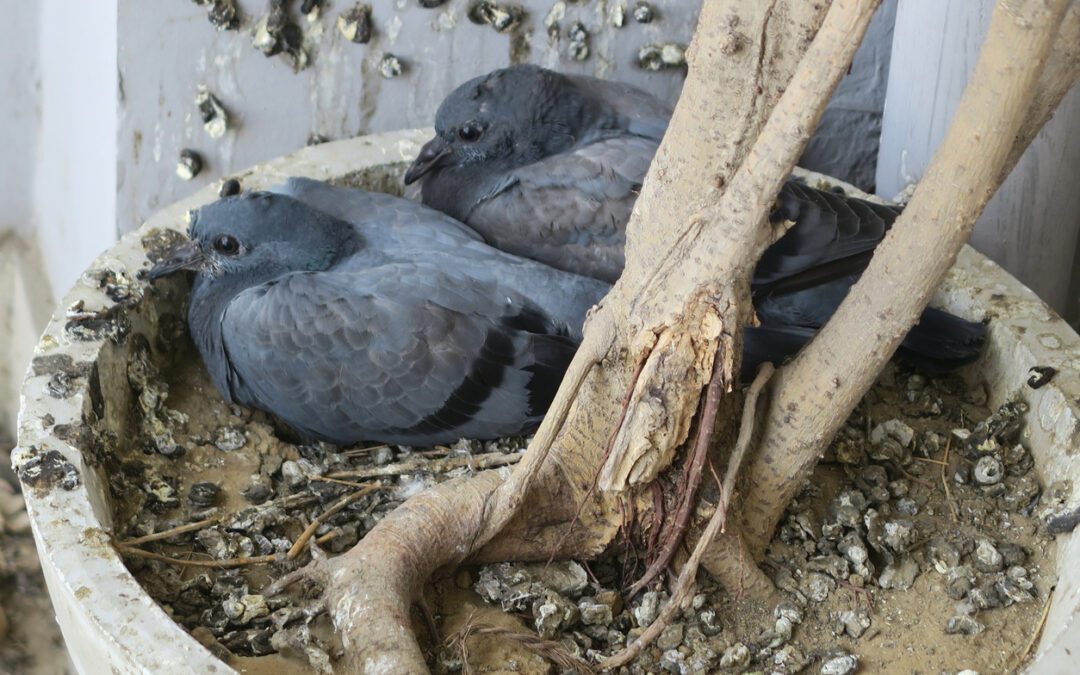
by Pigeon Patrol | Sep 25, 2024 | Bird Deterrent Products, Bird Law, Bird Netting
A controversial pesticide that has been banned through much of Europe and in New York City is being used to keep pigeons away from Red Deer’s downtown bus terminal.
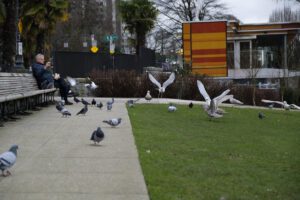
It’s a cloudy morning in British Columbia and it seems that this guy is accustomed to bring food for pigeons and seagullls.
A controversial pesticide that has been banned through much of Europe and in New York City is being used to keep pigeons away from Red Deer’s downtown bus terminal.
Steve Parkin, transit facilities superintendent for the City of Red Deer, confirmed on Wednesday that Calgary-based Abell Pest Control is using the pesticide, under the trade name of Avitrol, to stop pigeons from roosting at Sorensen Station.
The city contracted the company shortly after the station, on the corner of 49th Street and 49th Avenue, officially opened in September 2010.
Parkin said there were lots of pigeons at the time and they were “messing everywhere” with their droppings, which are considered a health hazard for humans. Bird spikes or nails were also installed to discourage birds from landing on the transit station.
Since this “anti-flocking agent” was introduced about a year to 18 months ago, Parkin said the pigeon population has been reduced.
Avitrol is placed in containers in the beams of the transit terminal.
“There’s still a couple of them flying around in there but not to the degree that it was, and the manure problem isn’t as bad,” said Parkin. “It’s feed that upsets their stomachs and make it a less desirable place, and they apparently rush off. The company tells us that they are funny creatures. If they can’t find a place they like and the food isn’t good, then they will move on.”
Parkin wasn’t certain what the agent was but after a phone call was made, he discovered it was Avitrol.
“They assured us it was a relatively safe way to control pigeons,” he said. “It won’t kill them, it affects their nerves, I guess.”
He said Inspections and Licensing Department, which controls the parkade above the transit terminal, is also using Abell Pest Control.
Calls to Abell Pest Control were not returned on Wednesday or Thursday.
Parkin said he wasn’t aware of any controversy surrounding Avitrol.
“All we did was contracted a certified pest control and that’s what they recommended,” he said.
Opponents of the chemical claim it’s inhumane and that it poisons non-target species that consume the bait or the carcasses of birds that have died as a result.
Carol Kelly, executive director for Medicine River Wildlife Centre near Spruce View, said Red Deer residents should be disappointed.
“It’s highly toxic and definitely deadly and goes up the food chain to peregrine falcons,” said Kelly. “Maybe in low dosages, some of those pigeons might recover. But I would not want to have that stuff spread around my community.”
Kelly is working to bring OvoControl, a birth control bait system for birds, to Canada. It’s being used across the United States and is getting good reviews for its effectiveness, she added.
According to the Avitrol website, the agent works on the central nervous system and the motor nervous system. Its action on the motor nervous system usually causes behaviours characteristic of those seen in an epileptic seizure.
The website also refers to renowned animal welfare advocate Dr. Harry C. Rowsell, who in his Assessment of Humaneness of Vertebrate Pesticides report from 1979, said that “although the ingestion of this product is visually repugnant, our studies suggest that the chemical does not cause pathological changes in the organs or tissues capable of causing pain or distress.”
“Birds eating the treated bait will be affected in a manner that, varying by species, will artificially cause them to emit distress and alarm cries and visual displays used by their species when they are frightened or injured,” says the website. “This may include flying erratically, vocalizing, trembling, dilation of the pupils and other symptoms indicative of loss of motor control. This will frighten the flock and cause it to leave the site.”
In laboratory testing, if the dose is lethal, death will usually occur within an hour following administration, reports the website.
The Ontario Ministry of Natural Resources has strict regulations surrounding the use of Avitrol, including disposing of any exterminated animals daily to prevent contact with humans or other animals. The restrictions are crucial as the province tries to protect threatened birds of prey and in particular, peregrine falcons, which like to eat pigeons.
Avitrol was developed to deter songbirds from damaging crops. As soon as the first few birds are intoxicated, they issue loud warning cries and the rest of the songbirds fly away.
“In other words, it was developed for birds who have a physiological ability to utter a distress call,” said Canadian naturalist Barry Kent MacKay in a 1999 article with the St. Louis-based The Riverfront Times. “Pigeons don’t. They cannot utter these loud alarm notes.”
New York state legislators were so concerned about the use of Avitrol that they banned it from use in major metropolitan areas such as New York City in 2000.
The Humane Society of the United States has described Avitrol as a poison that is not only unnecessary, but dangerous. It advocates effective humane solutions like the use of OvoControl as well as devices that keep birds off rooftops, windowsills and similar surfaces
Pigeon Patrol
Pigeon Patrol Products & Services is the leading manufacturer and distributor of bird deterrent (control) products in Canada. Pigeon Patrol products have solved pest bird problems in industrial, commercial, and residential settings since 2000, by using safe and humane bird deterrents with only bird and animal -friendly solutions. At Pigeon Patrol, we manufacture and offer a variety of bird deterrents, ranging from Ultra-flex Bird Spikes with UV protection, Bird Netting, 4-S Bird Gel and the best Ultrasonic and audible sound devices on the market today.
Canada’s top wholesaler for bird deterrent products for twelve consecutive years.
Contact us at 1- 877– 4– NO-BIRD, (604) 585-9279 or visit our website at https://www.pigeonpatrol.ca/
Bird Gone, Pigeon Gone, Pigeon problems, pigeon spikes, 1-877-4NO-BIRD, 4-S Gel, Bird Control, Pigeon Control, bird repellent, Bird Spikes, sonic bird repellent, stainless steel bird spikes, bird spikes Vancouver, Ultra Sonic Bird Control, Bird Netting, Plastic Bird Spikes, Canada bird spike deterrents, Pigeon Pests, B Gone Pigeon, Pigeon Patrol, pest controller, pest control operator, pest control technician, Pigeon Control Products, humane pigeon spikes, pigeon deterrents, pigeon traps, Pigeon repellents, Sound & Laser Deterrents, wildlife control, raccoon, skunk, squirrel deterrent, De-Fence Spikes, Dragons Den, Pigeon, Pigeon Patrol, Pigeons Roosting, Vancouver Pigeon Control, Bird Spikes, Bird Control, Bird Deterrent, Pigeon Deterrent, Surrey Pigeon Control, Pest, Seagull deterrent Vancouver Pigeon Blog, Birds Inside Home De-fence, Pigeon Nesting, Bird Droppings, Pigeon Dropping, woodpecker control, Keep The Birds Away, Birds/rats, seagull, pigeon, woodpecker, dove, sparrow, pidgeon control, pidgeon problem, pidgeon control, flying rats, pigeon Problems, bird netting, bird gel, bird spray, bird nails, bird guard, Pigeon control, Bird deterrents, Pigeon deterrents, Bird control, solutions, Pigeon prevention, Pigeon repellent, Bird proofing, Pest bird management, Pigeon spikes, Bird netting, Humane bird control, Bird exclusion, Urban bird control, Anti-roosting devices, Pigeon removal, Bird barriers

by Pigeon Patrol | Sep 19, 2024 | Bird Netting
MILFORD — Residents are being warned to keep their eyes to the sky next week when the Board of Health begins a pigeon control program intended to scare the birds away from the Town Hall’s historic bell tower.
Officials will use the poison Avitrol on corn kernels and, soon after ingestion, some pigeons are expected to fall to the ground dead.
“We’re doing this out of necessity to protect the historic building,” Health Agent Paul Mazzuchelli said of the problem of mounting pigeon droppings in the 19th century Town Hall bell tower.
Mazzuchelli said the public is being notified early to avoid what happened last summer when dozens of dead pigeons “fell from the sky” after officials at Milford Regional Medical Center tried to rid the building of the birds by poisoning them. They did not inform the public of the pigeon eradication plan.
“There were 15 pigeons dropping on the Store 24 parking lot,” recalled Middle School East Principal Joseph Pfiel of the day he looked across the street to the store’s parking lot and watched pigeons “falling from the sky” all around his car.
“I wish they had notified us. It was alarming to a lot of people,” Pfiel said yesterday.
Because the poisoning program was done in late summer at the height of the West Nile virus scare and at a time when cases of deadly Eastern Equine Encephalitis were turning up in the area, officials quickly became alarmed at the report of dead birds.
About 12 to 15 of the dead birds were sent to the state testing lab in Jamaica Plain. Mazzuchelli said the results were negative, but until officials found out about the poisoning program at the hospital, they were at a loss as to why the birds were dropping dead around town.
The situation was so bad that selectmen decided in November that if pigeons in Milford were to be poisoned again, the public should be notified first.
While other methods have been tried to keep the pigeons away, including hanging a plastic owl and snake from the tip of the bell tower to scare away the birds, officials said they were only temporary deterrents.
Mazzuchelli said the Board of Health recently received permission from the Division of Fisheries and Wildlife to conduct the poisoning program. Although pigeons are not a protected species, the use of the poison Avitrol is restricted and therefore a permit was necessary, he said.
The program will start with a prebaiting phase during which Mazzuchelli will put out whole corn kernels on the ledge of the bell tower. The kernels will be glued and strung to a basket and lowered onto the ledge so the kernels won’t blow off in a wind or rainstorm. Once the pigeons begin to accept the bait, the Avitrol will be added.
Mazzuchelli said those birds that ingest the corn will begin to exhibit peculiar behavior very quickly. They may wobble or fall backward or “fall from the sky,” dead within 30 minutes, he said.
It is hoped that only a few birds will eat the bait and that the other pigeons will learn the tower is not a good place to roost, Mazzuchelli said. If any other birds, such as robins, are seen eating the bait, the program will be stopped temporarily.
“Everything is being done properly,” he said. All environmental concerns have been addressed.
If anyone sees a pigeon acting strangely or a dead pigeon they should contact the Board of Health at 508-634-2315, and the bird will be picked up. If a cat or other animal gets to the dead pigeon before the Board of Health or animal control officer, residents should be aware that even if the animal eats the bird, they will not be harmed by the poison, Mazzuchelli said.
Mazzuchelli said the poisoning program is a last resort to save the bell tower from the continuing damage caused by pigeon droppings.
The poisoning program would cost about $6,500 to $6,900, but because the health agent will do it with the help of a certified adviser, the cost to the town will drop to about $2,000.
If netting was used in the bell tower, the costs would be $40,000 or more, Mazzuchelli said. “It’s a very expensive process,” he said of the netting, which would be difficult to put up because of the architectural design of the tower.
If poisoning fails and the pigeons return to roost on Town Hall, it may have to be repeated.

A fishing boat surrounded by seagulls.
No one knows exactly how long the pigeons have roosted downtown, but for decades pigeons have flocked to the high towers of St. Mary’s Church, Town Hall, the vacant granite buildings of the old Stacy School and the Granite Building and to the roofs and ledges of other tall buildings such as Middle School East. The bird droppings have created a nuisance and potential health hazard for students, staff, parishioners and residents, Mazzuchelli said.
At Town Hall, the pigeon problem was so bad years ago that the moisture began penetrating the ceiling in the third-floor hall after pigeons flew into the rafters through broken attic windows, Mazzuchelli said.
Mazzuchelli said employees could actually smell the pigeons in certain areas of the building, including the lower level. Even now on a hot, musty day, some people say they can still smell the remnants of pigeons in the building.
While the pigeons left Town Hall last summer after a fire in the clock tower located just below the bell, they returned in recent months creating a mess in the open tower. Pigeon droppings are now covering the historic Holbrook Bell and once again seeping into the floor and ledges of the building.
Pigeon Patrol
Pigeon Patrol Products & Services is the leading manufacturer and distributor of bird deterrent (control) products in Canada. Pigeon Patrol products have solved pest bird problems in industrial, commercial, and residential settings since 2000, by using safe and humane bird deterrents with only bird and animal -friendly solutions. At Pigeon Patrol, we manufacture and offer a variety of bird deterrents, ranging from Ultra-flex Bird Spikes with UV protection, Bird Netting, 4-S Bird Gel and the best Ultrasonic and audible sound devices on the market today.
Canada’s top wholesaler for bird deterrent products for twelve consecutive years.
Contact us at 1- 877– 4– NO-BIRD, (604) 585-9279 or visit our website at https://www.pigeonpatrol.ca/
Bird Gone, Pigeon Gone, Pigeon problems, pigeon spikes, 1-877-4NO-BIRD, 4-S Gel, Bird Control, Pigeon Control, bird repellent, Bird Spikes, sonic bird repellent, stainless steel bird spikes, bird spikes Vancouver, Ultra Sonic Bird Control, Bird Netting, Plastic Bird Spikes, Canada bird spike deterrents, Pigeon Pests, B Gone Pigeon, Pigeon Patrol, pest controller, pest control operator, pest control technician, Pigeon Control Products, humane pigeon spikes, pigeon deterrents, pigeon traps, Pigeon repellents, Sound & Laser Deterrents, wildlife control, raccoon, skunk, squirrel deterrent, De-Fence Spikes, Dragons Den, Pigeon, Pigeon Patrol, Pigeons Roosting, Vancouver Pigeon Control, Bird Spikes, Bird Control, Bird Deterrent, Pigeon Deterrent, Surrey Pigeon Control, Pest, Seagull deterrent Vancouver Pigeon Blog, Birds Inside Home De-fence, Pigeon Nesting, Bird Droppings, Pigeon Dropping, woodpecker control, Keep The Birds Away, Birds/rats, seagull, pigeon, woodpecker, dove, sparrow, pidgeon control, pidgeon problem, pidgeon control, flying rats, pigeon Problems, bird netting, bird gel, bird spray, bird nails, bird guard, Pigeon control, Bird deterrents, Pigeon deterrents, Bird control, solutions, Pigeon prevention, Pigeon repellent, Bird proofing, Pest bird management, Pigeon spikes, Bird netting, Humane bird control, Bird exclusion, Urban bird control, Anti-roosting devices, Pigeon removal, Bird barriers
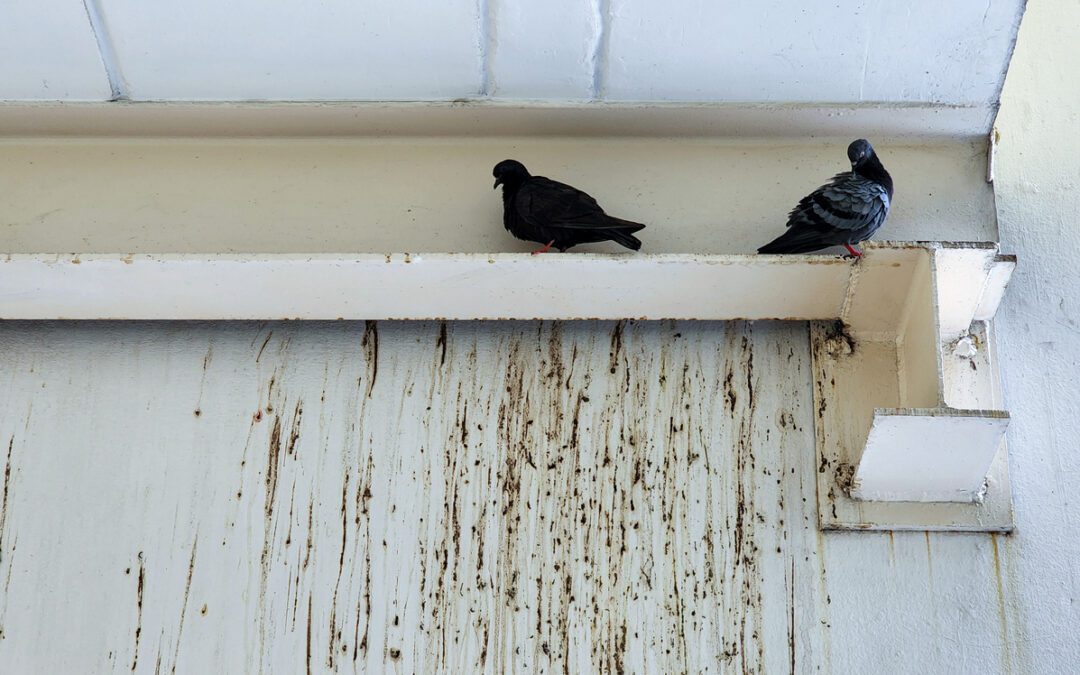
by Pigeon Patrol | Sep 19, 2024 | Bird Netting
It started when the exclusive University Club had its feathers ruffled. It wanted to drape its storied building in netting, to protect it from pigeon poo, which eats away at stone and metal. But the Landmarks Commission said it would have to wait for approval, as it would be a “visible change” to the landmarked Italian Renaissance building’s façade. As if the crap wasn’t a “visible change” enough.
Meanwhile, over on East 93rd Street, there was a scuffle involving longtime pigeon activist Anna Dove and her neighbor, who snatched away her bag of seed after he saw her feeding the pigeons on the sidewalk. The police were summoned.
“It’s disgusting,” said her nemesis, retired teacher Arthur Schwartz. “She’s feeding the rats.”
And with the live pigeon-shooting state championships in Pennsylvania coming up, it’s almost guaranteed that there will be an increase in demand of pigeon-poaching — New York City is a favorite spot for trapping them and transporting them to be used as live targets. The animal-rights activists will be out with their cameras and signs to stop them.
AD
No matter which side you’re on, one things for certain — by the end, things are going to get a little birdbrained.
*
“It’s not the pigeons that are the problem, it’s the number of them,” says Andrew D. Blechman, author of “Pigeons: The Fascinating Saga of the World’s Most Revered and Reviled Bird.” “They’re gentle creatures. The problem is that they get in our face, just like we get in each other’s faces.”
No one one’s quite sure of how many pigeons are in New York City. One adage is “one pigeon per person,” which would put their numbers at about 7 million. They each produce about 25 pounds of waste per year.
Pigeons love cities because of the many ledges, windowsills, eaves and rooftops available for them to roost in, which mimics their natural habitat of high cliffs. Pigeon pairings are monogamous, often mating for life, and both parents raise the babies — called squab — for a time, sitting on the eggs in shifts.
The pigeon includes about 298 species of bird, but the Rock Dove is the most common to the New York area, according to the Parks Department. The grey, bobbing-headed birds usually have purple-green iridescence around the neck area. They’re the scruffiest members of the dove family — although “dove” usually connotes the pure white symbols of peace, not the pizza scavengers of city streets. (Just say they’ve been pigeonholed.)
“If they were white,” Blechman says, “people would love them.”
Blame the French for our pigeon problems. The little pluckers first arrived in the early 1600s with French settlers who used them for meat. They were easy to raise — they could be kept in a barn, where they’d perch on the rafters, and young pigeons served as a good source of protein.
But they soon escaped their confines and went feral.
City life agreed with them and allowed them to flourish — and in some cases, over-flourish. Their natural predators, like falcons and hawks, aren’t found here in great numbers.
Courtney Humphries, author of “Superdove: How the Pigeon Took Manhattan . . . And the World,” concedes that pigeon are pilloried partly because of their “persistence. They nest on the buildings we consider our territory, and they don’t like to be moved.”
The average city pigeon has a lifespan of three to five years. With all the food scattered throughout the garbage cans and sidewalks — plus well-meaning human feeders — they spend less time looking for grub, which leaves more time for mating.
“The biggest problem is the people who overfeed them,” says Blechman. “Every city has about a dozen of them, and they’re the ones who cause the [overpopulation] problem.”
He suggests that if you want to feed the birds, hand out just a teaspoon full of birdseed for a flock. “It’s just enough to give them a little extra energy while they’re out trying to find their own food.”
“If nobody fed pigeons, I think things would look a lot different,” agrees Humphries, who says that human feeders end up creating dense flocks. “A lot of the problem with pigeons comes from people.”
If you can’t freeze the hearts of little old ladies, though, you could try eating them (the pigeons, that is). Squab — baby pigeons that haven’t flown yet — is on the menu at many restaurants around the city, particularly French. They’re “basically the milk-fed veal of the sky,” says Blechman — tender, mostly dark meat, and one of the only poultry that can be eaten rare. (Pigeons produce their own milk-like substance, which they feed to their young by regurgitation.)
Pigeon pot pie was a huge colonial favorite. Today, try the Squab and Foie Croustillant at the Modern, Danny Meyer’s restaurant at the Museum of Modern Art.
*
Unless the appetite for squab skyrockets, New York’s options are few. Avicide — poisoning birds — was made illegal in 2000, when the state Legislature passed a bill outlawing the use of “flock dispersal agents” like Avitrol in cities with more than 1 million people.
Before that, property managers regularly hired pest control services to dole out Avatrol to flocks of pigeons.
“In theory, you would mix it with feed, and when one pigeon ate some of the treated food, they would begin to suffer from neurological toxicity,” explained Stephanie Boyles, wildlife expert at the Humane Society of the United States. “When their flockmates saw them suffering, it would prompt them to leave the area.”
In practice, however, overdosing often led to large numbers of birds convulsing and writhing in pain on the street before their deaths. Welcome to New York!
The last major flare-up between pigeons and people was in 2007, when City Councilman Simcha Felder released a report plaintively titled, “Curbing the Pigeon Conundrum.”
Claiming that their droppings carried a host of diseases like histoplasmosis, he proposed a $1,000 fine to anyone feeding them, as well as curbing their numbers through birth control (a measure that cities like Los Angeles have adopted, although some argue that it’s unsustainable), and appointing a city “Pigeon Czar” to oversee other pigeon-control issues.
The NYC Department of of Health and Mental Hygiene maintains that contact with their droppings only poses a small health risk, and that “routine cleaning of droppings (e.g. from windowsills) does not pose a serious health risk to most people,” although disposable gloves are a good idea.
The Humane Society came out against the anti-feeding fine because they weren’t sure it would actually make a difference in reducing flocks, said Boyles. “We still suggest working with communities to create places where pigeons are welcome, and discouraging them where they’re not.”
While Felder’s bill didn’t fly, it was only one of many efforts to keep pigeons clipped.
In 2006, pigeon loitering was so dense near the Army Recruitment Center in Times Square, speakers were set up to broadcast sounds of falcons and pigeons being attacked, in hopes of scaring them away. In 2003, they had so overwhelmed Bryant Park that the operators invited a falconer and his hawk to the park for a week to scare away (not eat) the pigeons.
In 2007, the MTA installed Bird-B-Gone on some of its elevated stations along the 7 line, as well as others. The electronic system zapped birds that got too close.
In the ’80s, plastic owls were a big seller. Today, a slightly more high-tech version, called the RoboHawk, moves its head, wings, and makes what its creators hope are pigeon-threatening sounds.
Every so often, a politician considers reviving an overall anti-feeding bill, since, for now, it’s only illegal in city parks where signs are posted (the fine is usually $50).
Some cling to the hope that the city will come to its senses and declare war. Because they’re a non-native species, pigeons are not protected by either the Federal Migratory Birds Act or New York state laws. Can anyone say hunting season?
It’s got to be done mafia-style, though. Culling is only a temporary solution — as with most wild birds, quick breeding will put their numbers back to pre-cull figures within weeks, according to Pigeon Control Advisory Service.
*
But spare a thought, pigeon haters, for your majestic foe. Pigeons have more qualities than you think.
Although city birds aren’t particularly active, pigeons are built to be athletes — a trained bird can fly up to 60 miles per hour, and they can stay in the air for 500 miles. They’re meant for flying long distances, and have “homing” instincts, which means they will naturally find their way back.
This talent is why they were literally drafted into the United States Army Pigeon Service.
A million served in both world wars, where they delivered messages across enemy lines and saved thousands of soldiers’ lives. One pigeon, Cher Ami, won a French medal for his bravery for flying through gunfire, finally delivering the message dangling from what was left of his foot. He’s now stuffed and in the Smithsonian.
The army’s Pigeon Breeding and Training Center was based at Fort Monmouth, NJ, and opened in 1917. Many of its “Pigeoneers” were “basically just boys out of Brooklyn, and they’d just bring their best birds,” Humphries says. (The training center was closed in 1957 when the Army stopped using them as messengers.)
Keeping pigeons on rooftops — and racing them — used to be much more popular. Who can forget Marlon Brando’s character in the 1954 film “On the Waterfront” shouting up to his friend Joey, “I got one of your birds!” right before Joey “accidentally” falls off the roof?
The city is full of equally vocal bird-lovers.
“They animate our lives,” argues Blechman, who says that despite writing a book on pigeons, he is not a “bird person,” and admits to having eaten them before. He’s come around, though. “You look out the window and you can have a pigeon land on your windowsill, and the same one will come back every day, and at the same time.
“What would the lonely, the unemployed, and the elderly do every day if it weren’t for pigeons?”
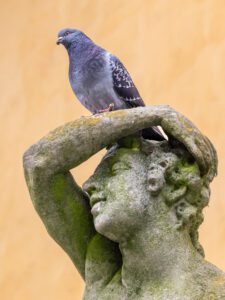
The Internet is atwitter with kooky pigeon fans. There’s a pigeon appreciation society on Facebook. On photo-sharing site Flickr, there’s a group called The Global Pigeon Art Appreciation Society.
“You are not alone,” the site reads. “Many artists have been inspired by pigeons.”
There is also a city listserv called “New York Pigeon People,” where members discuss how to rescue birds and share pigeon news.
You can eat them, race them, breed them, feed them, but you can’t escape them, whether you consider them the most misunderstood creatures of the flying community or the world’s worst bird. As Blechman put it, “We’re just going to have to learn to co-exist.”
Pigeon Patrol
Pigeon Patrol Products & Services is the leading manufacturer and distributor of bird deterrent (control) products in Canada. Pigeon Patrol products have solved pest bird problems in industrial, commercial, and residential settings since 2000, by using safe and humane bird deterrents with only bird and animal -friendly solutions. At Pigeon Patrol, we manufacture and offer a variety of bird deterrents, ranging from Ultra-flex Bird Spikes with UV protection, Bird Netting, 4-S Bird Gel and the best Ultrasonic and audible sound devices on the market today.
Canada’s top wholesaler for bird deterrent products for twelve consecutive years.
Contact us at 1- 877– 4– NO-BIRD, (604) 585-9279 or visit our website at https://www.pigeonpatrol.ca/
Bird Gone, Pigeon Gone, Pigeon problems, pigeon spikes, 1-877-4NO-BIRD, 4-S Gel, Bird Control, Pigeon Control, bird repellent, Bird Spikes, sonic bird repellent, stainless steel bird spikes, bird spikes Vancouver, Ultra Sonic Bird Control, Bird Netting, Plastic Bird Spikes, Canada bird spike deterrents, Pigeon Pests, B Gone Pigeon, Pigeon Patrol, pest controller, pest control operator, pest control technician, Pigeon Control Products, humane pigeon spikes, pigeon deterrents, pigeon traps, Pigeon repellents, Sound & Laser Deterrents, wildlife control, raccoon, skunk, squirrel deterrent, De-Fence Spikes, Dragons Den, Pigeon, Pigeon Patrol, Pigeons Roosting, Vancouver Pigeon Control, Bird Spikes, Bird Control, Bird Deterrent, Pigeon Deterrent, Surrey Pigeon Control, Pest, Seagull deterrent Vancouver Pigeon Blog, Birds Inside Home De-fence, Pigeon Nesting, Bird Droppings, Pigeon Dropping, woodpecker control, Keep The Birds Away, Birds/rats, seagull, pigeon, woodpecker, dove, sparrow, pidgeon control, pidgeon problem, pidgeon control, flying rats, pigeon Problems, bird netting, bird gel, bird spray, bird nails, bird guard, Pigeon control, Bird deterrents, Pigeon deterrents, Bird control, solutions, Pigeon prevention, Pigeon repellent, Bird proofing, Pest bird management, Pigeon spikes, Bird netting, Humane bird control, Bird exclusion, Urban bird control, Anti-roosting devices, Pigeon removal, Bird barriers
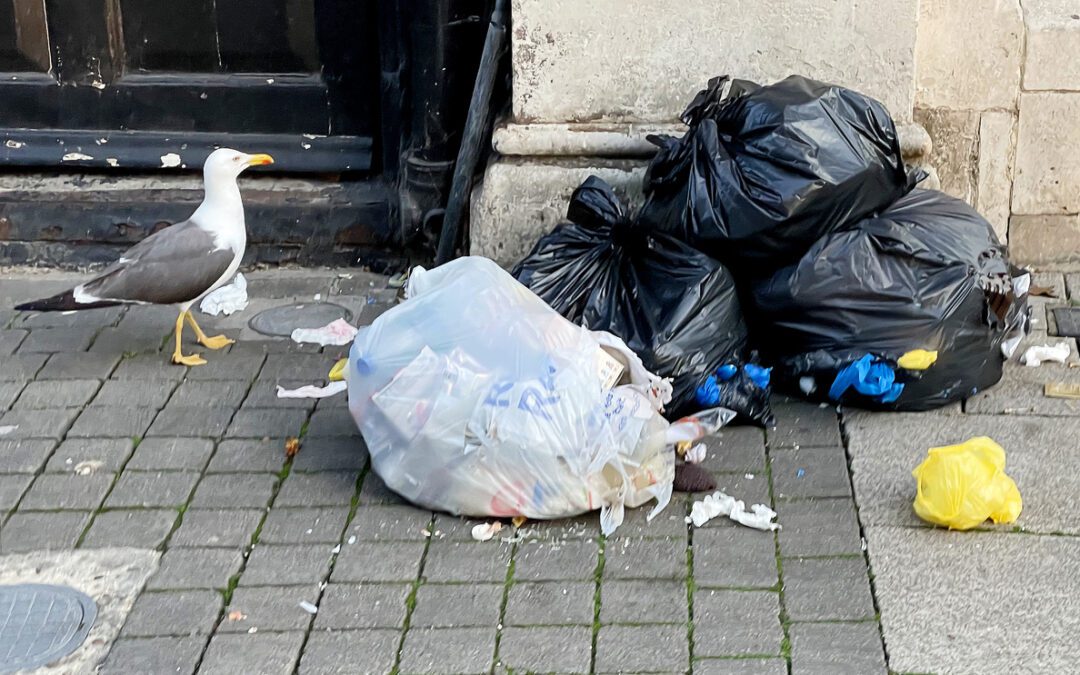
by Pigeon Patrol | Sep 19, 2024 | Bird Netting
April 23 – In a messy but unsuccessful war against pigeons on city buildings, Denver has tried highfrequency sirens, electrified toe strips and an anti-perching product called Hot Foot. But now city officials think they finally have found a weapon that works: hallucinogenic chemicals.
For the past year, the city has been feeding pigeons corn laced with a substance called Avitrol, which sends birds into convulsions, sometimes fatal, that scare away the rest of the flock.
With so many pigeons on bad trips, city workers say it’s the first time in memory that people can walk without fear of plops from the ledges, windowsills and outcroppings of the ornate City and County Building and Greek Theater.
The acidity in pigeon droppings had become such a potent problem that the city is spending $100,000 this summer to power-wash bird scat from buildings around Civic Center.
“It got to the point where you felt like you needed ski goggles to look up at the City and County Building,” said John Hall, manager of public office buildings for Denver. “Pigeons are urban vermin.”
Though the same Avitrol chemical also is being used against pigeons at Coors Field, St. John’s Episcopal Cathedral and Rose Medical Center, not everyone is convinced it’s the No. 1 solution to the No. 2 problem.
Just a few blocks across Civic Center, state maintenance workers worry that Denver Mayor Wellington Webb merely is scattering pigeons from his building to do their business on the state Capitol.
And animal-rights activists are aghast.
“It takes 40 pigeons pooping all day in one place to equal what a dog leaves on my lawn in one drop,” said Catherine Hurlbutt, 87, who has rescued and nurtured hundreds of injured birds at her south Denver home. “You’re not supposed to say a bad word about dogs, but people think it’s OK to poison pigeons.”
When New York City residents started using Avitrol on pigeons, Grace Slick, the famed Jefferson Airplane singer of the ’60s drug anthem “White Rabbit,” protested to Mayor Rudy Giuliani in a letter.
“I have considerable experience on the subject of mind-altering drugs, and I can tell you that Avitrol is not your run-of-the-mill hallucinogen,” Slick wrote. “It causes violent shaking, trembling, thirst, nausea, convulsions, disorientation and a slow death. Wow, talk about a bad trip!”
Last year, the New York State Assembly passed a bill allowing cities to ban Avitrol, but Gov. George Pataki, heeding a request from Giuliani, vetoed the bill.
All the flap is over a 1-pound bird that was native to Europe but brought to North America in the 1600s.
Supporters call them rock doves, which mate for life and feed milk to their young, and note that their homing ancestors helped in World War II by transporting spy messages. Detractors liken them to rats and cockroaches that carry diseases and dive-bomb passers-by with fecal glop.
Denver has struggled for decades to keep Downtown pigeons under control. When workers put spikes on building ledges to keep pigeons from roosting, the birds simply built nests atop them and enjoyed air-cooled nests in the summer. When workers tried a chemical spread called Hot Foot, birds built new nests and enjoyed warmer roosts for the winter.
When world leaders visited Denver for the Summit of the Eight in 1997, city workers installed electrified wires atop ledges favored by pigeons at Civic Center’s outdoor Greek Theater. The wires suffered from frequent short-circuits.
High-frequency radio speakers were supposed to drive the pigeons batty, but the birds ended up perching atop them anyway.
City officials said their war against pigeons seemed lost – until Denver hired the Pigeon Man.
The latest owner of a 47-year-old family business called Bird Control, Doug Stewart said Avitrol is one of his most effective tools against pigeons. When he started working for Denver a year ago, the City and County Building was home to hundreds of pigeons.
But with a $250-a-month city contract, Stewart started sprinkling Avitrol-laced corn on the roof of city hall. Recently, Stewart scrambled across the roof of the four-story building with his monthly dosage of bait in his backpack.
While the rooftop view of the Rocky Mountains to the west and the state Capitol to the east was magnificent, Stewart was most proud of something he didn’t see.
There were few birds, or fresh droppings, anywhere.
So he laid down a few small piles of Avitrol-laced corn, which costs him $50 a pound, and talked about a job that has taken him across the rooftops of the city, from Lakeside Mall to the steeple at St. John’s Episcopal Cathedral – and some truly disgusting abandoned apartment buildings in-between.
“I get asked all the time: Am I killing pigeons?” Stewart said. “There’s no way in the world I want any dead pigeons. I want to keep them fat, happy and on the move. It’s good for my business.” According to the government-approved warning label, Avitrol is a “poison with flock-alarming properties, used for the control of feral pigeons in, on, or in the area of structures, feeding, nesting, loafing and roosting sites, in such a way that a part of the flock may react and frighten the rest away. Birds that react and alarm a flock usually die.”
Scientific studies show the chemical temporarily alters brain waves and throws the bird into spasms and convulsions. When an Ontario, Canada, environmental official banned the use of non-humane vertebrate pesticides in 1975, a team of University of Ottawa researchers concluded that Avitrol “appears to be humane based on scientific evidence.”
“Upon eating the active ingredient of Avitrol in a corncob base, the birds begin to flap wings, vocalize and convulse,” said the study led by pathologist Henry Roswell.
“Other birds seeing this activity in their colleagues become alarmed and fly away to another area.” Critics of the use of bird repellants such as Avitrol claim that their use merely shifts birds from one area to another.
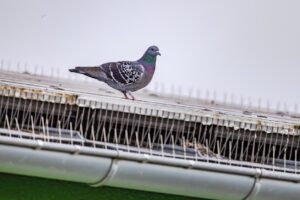
Pigeon on a roof with solar panels with pigeon spikes to repel pigeons, Darmstadt, Germany
“Avitrol is not intended to kill birds. However, some do die, although the numbers are minimal in comparison to the hundreds that make up the flock,” Roswell said.
Death-rate estimates range from 1 percent to 20 percent of pigeons consuming Avitrol.
Meanwhile, workers at the Colorado Capitol wonder whether the city is dropping its pigeon problem on the state. In the past year, state workers have installed five special anti-pigeon Plexiglas barriers – at a cost of $300 each – on ledges above the Capitol’s west steps. When told Denver has been using a chemical that may be moving city birds to the state Capitol, state central services director Rick Malinowski said, “Thanks a lot! We may have to retaliate.”
City workers fear the consequences. At the city’s Greek Theater, maintenance worker Ray Martinez set down his coffee cup one morning on an outdoor step before walking inside an office.
When he returned to his coffee cup a few minutes later, he saw something that jolted him awake.
“I was ready to take a sip and I looked down and thought, “Hey, what’s going on here? I take my coffee black!’
” Martinez said. “I was so mad I threw my cup at that bird.”
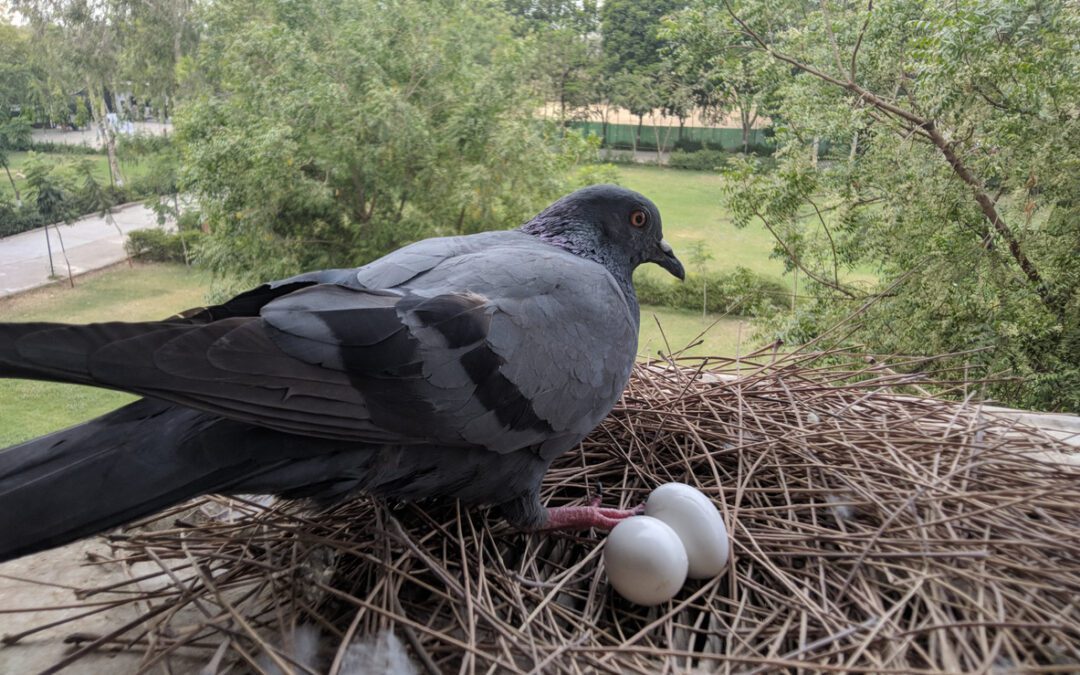
by Pigeon Patrol | Sep 19, 2024 | Bird Netting
AINESVILLE, Fla. — A Florida Museum of Natural History gallery exhibit opening Sept. 1 illustrates how human actions can lead to the extinction of a species—even those considered common just a century ago.
“A Shadow Over the Earth: The Life and Death of the Passenger Pigeon” marks the 100-year anniversary of the bird’s extinction, and features illustrations, artwork and poetry from famed naturalists who documented the pigeon’s biology and its decline. Visitors may also learn about related Florida Museum research and view a well-preserved pair of Passenger Pigeons mounted in the 1890s.
Prior to its extinction 100 years ago, the Passenger Pigeon was one of the most abundant birds in the world, with population estimates ranging from 3 billion to 5 billion.
“James Audubon witnessed a flock that took three days to fly over a locality in north central Kentucky,” said Jessica Oswald, a former Florida Museum ornithology graduate student.
The populous pigeons couldn’t survive large-scale commercial hunting and habitat loss, however. The world’s last Passenger Pigeon, named Martha, died in the Cincinnati Zoo and Botanical Garden on Sept. 1, 1914, at 29 years old.
“Museum scientists have been studying endangered and extinct birds around the world for 20 years,” Florida Museum exhibit developer Tina Choe said. “We’re very excited to highlight the Passenger Pigeon story because understanding the past is one key to a better future.”
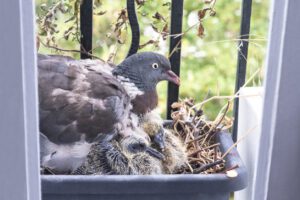
Baby pigeons with mother (wood pigeon), born in a flower pot, on the windowsill, in Paris, France.
The exhibit explains how the loss of the Passenger Pigeon changed social attitudes and spurred new legislation protecting migratory birds, which played a part in saving other species from the same fate. It takes more than laws to conserve wildlife, however, so visitors may learn in the exhibit what small, easy steps they can take to protect Florida’s native birds.
Pigeon Patrol
Pigeon Patrol Products & Services is the leading manufacturer and distributor of bird deterrent (control) products in Canada. Pigeon Patrol products have solved pest bird problems in industrial, commercial, and residential settings since 2000, by using safe and humane bird deterrents with only bird and animal -friendly solutions. At Pigeon Patrol, we manufacture and offer a variety of bird deterrents, ranging from Ultra-flex Bird Spikes with UV protection, Bird Netting, 4-S Bird Gel and the best Ultrasonic and audible sound devices on the market today.
Canada’s top wholesaler for bird deterrent products for twelve consecutive years.
Contact us at 1- 877– 4– NO-BIRD, (604) 585-9279 or visit our website at https://www.pigeonpatrol.ca/
Bird Gone, Pigeon Gone, Pigeon problems, pigeon spikes, 1-877-4NO-BIRD, 4-S Gel, Bird Control, Pigeon Control, bird repellent, Bird Spikes, sonic bird repellent, stainless steel bird spikes, bird spikes Vancouver, Ultra Sonic Bird Control, Bird Netting, Plastic Bird Spikes, Canada bird spike deterrents, Pigeon Pests, B Gone Pigeon, Pigeon Patrol, pest controller, pest control operator, pest control technician, Pigeon Control Products, humane pigeon spikes, pigeon deterrents, pigeon traps, Pigeon repellents, Sound & Laser Deterrents, wildlife control, raccoon, skunk, squirrel deterrent, De-Fence Spikes, Dragons Den, Pigeon, Pigeon Patrol, Pigeons Roosting, Vancouver Pigeon Control, Bird Spikes, Bird Control, Bird Deterrent, Pigeon Deterrent, Surrey Pigeon Control, Pest, Seagull deterrent Vancouver Pigeon Blog, Birds Inside Home De-fence, Pigeon Nesting, Bird Droppings, Pigeon Dropping, woodpecker control, Keep The Birds Away, Birds/rats, seagull, pigeon, woodpecker, dove, sparrow, pidgeon control, pidgeon problem, pidgeon control, flying rats, pigeon Problems, bird netting, bird gel, bird spray, bird nails, bird guard, Pigeon control, Bird deterrents, Pigeon deterrents, Bird control, solutions, Pigeon prevention, Pigeon repellent, Bird proofing, Pest bird management, Pigeon spikes, Bird netting, Humane bird control, Bird exclusion, Urban bird control, Anti-roosting devices, Pigeon removal, Bird barriers
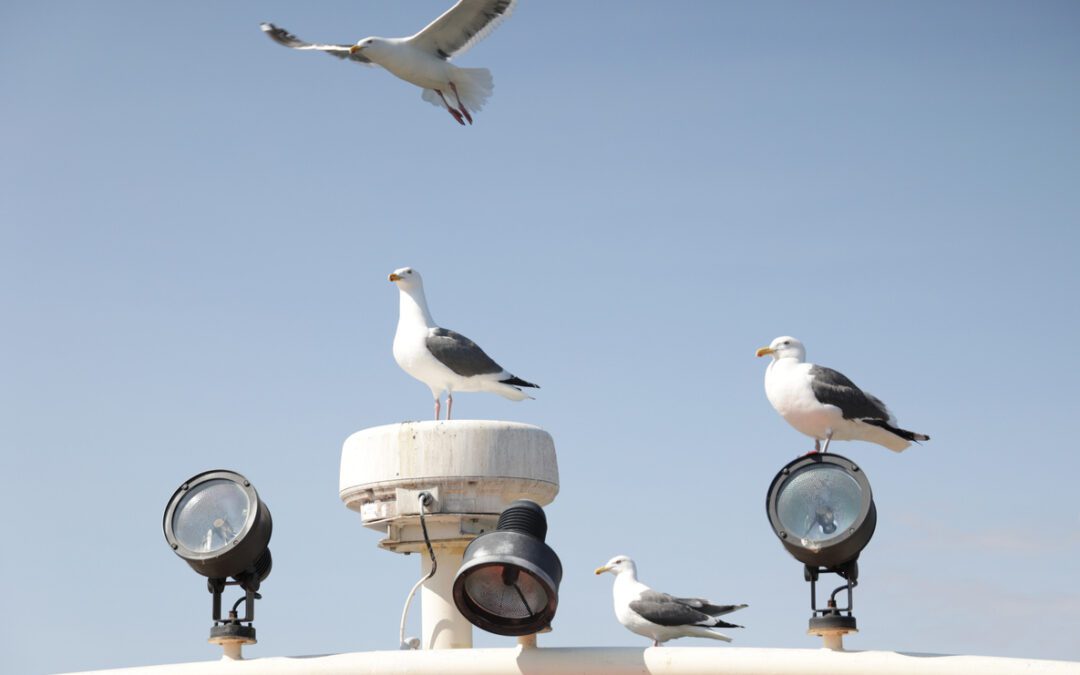
by Pigeon Patrol | Sep 19, 2024 | Bird Netting
It’s a modern mystery: how did 60,000 homing pigeons get lost between France and England on June 29, 1997, during the race commemorating the hundredth anniversary of the Royal Pigeon Racing Association? Unraveling the cause of this bizarre event, Jonathan Hagstrum of the U.S. Geological Survey may have finally filled in the pieces to the more ancient question of how these remarkable birds normally find their way home from distant unfamiliar places in all weather, day or night, in the first place.
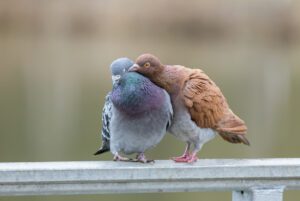
Feral pigeons (Columba livia domestica) in love.
Pigeon Patrol
Pigeon Patrol Products & Services is the leading manufacturer and distributor of bird deterrent (control) products in Canada. Pigeon Patrol products have solved pest bird problems in industrial, commercial, and residential settings since 2000, by using safe and humane bird deterrents with only bird and animal -friendly solutions. At Pigeon Patrol, we manufacture and offer a variety of bird deterrents, ranging from Ultra-flex Bird Spikes with UV protection, Bird Netting, 4-S Bird Gel and the best Ultrasonic and audible sound devices on the market today.
Canada’s top wholesaler for bird deterrent products for twelve consecutive years.
Contact us at 1- 877– 4– NO-BIRD, (604) 585-9279 or visit our website at https://www.pigeonpatrol.ca/
Bird Gone, Pigeon Gone, Pigeon problems, pigeon spikes, 1-877-4NO-BIRD, 4-S Gel, Bird Control, Pigeon Control, bird repellent, Bird Spikes, sonic bird repellent, stainless steel bird spikes, bird spikes Vancouver, Ultra Sonic Bird Control, Bird Netting, Plastic Bird Spikes, Canada bird spike deterrents, Pigeon Pests, B Gone Pigeon, Pigeon Patrol, pest controller, pest control operator, pest control technician, Pigeon Control Products, humane pigeon spikes, pigeon deterrents, pigeon traps, Pigeon repellents, Sound & Laser Deterrents, wildlife control, raccoon, skunk, squirrel deterrent, De-Fence Spikes, Dragons Den, Pigeon, Pigeon Patrol, Pigeons Roosting, Vancouver Pigeon Control, Bird Spikes, Bird Control, Bird Deterrent, Pigeon Deterrent, Surrey Pigeon Control, Pest, Seagull deterrent Vancouver Pigeon Blog, Birds Inside Home De-fence, Pigeon Nesting, Bird Droppings, Pigeon Dropping, woodpecker control, Keep The Birds Away, Birds/rats, seagull, pigeon, woodpecker, dove, sparrow, pidgeon control, pidgeon problem, pidgeon control, flying rats, pigeon Problems, bird netting, bird gel, bird spray, bird nails, bird guard, Pigeon control, Bird deterrents, Pigeon deterrents, Bird control, solutions, Pigeon prevention, Pigeon repellent, Bird proofing, Pest bird management, Pigeon spikes, Bird netting, Humane bird control, Bird exclusion, Urban bird control, Anti-roosting devices, Pigeon removal, Bird barriers












